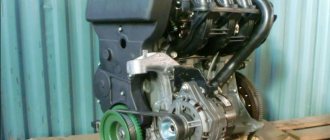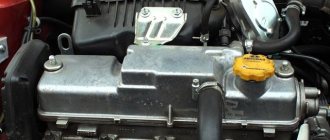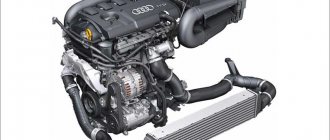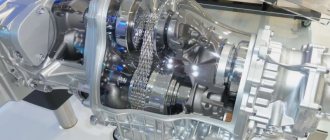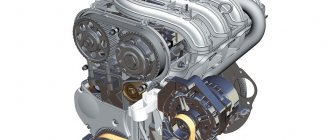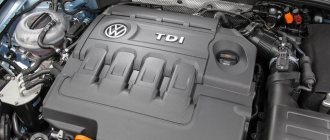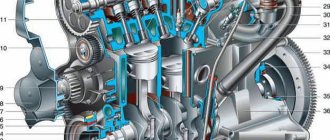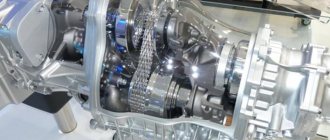In order to drive new models, engineers had to develop the VAZ 21129 engine, for which they took the VAZ 21179 engine as the basis. The receiver received a fairly large number of modifications, which allowed it to become popular and be placed under the hood of new cars.
But this engine cannot be called new, since it was still the same engine, on which the engineers worked hard. They managed to remove almost all the problem areas that owners of cars with the previous power unit under the hood encountered.
Specifications
| Engine capacity, cc | 1596 |
| Maximum power, hp | 106 |
| Maximum torque, N*m (kg*m) at rpm. | 148 (15) / 4200 |
| Fuel used | Gasoline AI-92 Gas/gasoline |
| Fuel consumption, l/100 km | 6.9 — 9 |
| engine's type | In-line, 4-cylinder |
| Add. engine information | distributed fuel injection |
| Maximum power, hp (kW) at rpm | 106 (78) / 5800 |
| Compression ratio | 10.5 |
| Cylinder diameter, mm | 82 |
| Piston stroke, mm | 75.6 — 84 |
| Number of valves per cylinder | 4 |
Design nuances
Engine Nissan YD25DDTi
The 21179 engine bears little resemblance to the basic version 21127, as both the design and appearance have changed:
- phasing of intake valves within ±30 degrees;
- hollow camshafts with cams using powder metallurgy;
- vortex air supply into the combustion chamber;
- cylinder cooling system (jacket);
- improved configuration and cylinder head gasket volumes;
- ShPG Federal Mogul;
- Korean pump;
- inclined drilling of oil channels in the crankshaft journals;
- polymer cylinder head cover and solid aluminum pan;
- flywheel for clutch 215 mm, which is recommended by the manufacturer.
Motor gaskets
ShPG from Federal Mogul
Peculiarities
This was in fact not a new internal combustion engine at all, since it received major improvements that ensured compliance with Euro 5 environmental standards. At the same time, minor changes were observed in the mechanical part of the engine.
The characteristics of the VAZ 21129 engine were ensured by the fact that it was an in-line power unit with four cylinders and without a turbine. Its displacement is 1.6 liters and its maximum power is 106 horsepower. At the same time, peak torque reaches 148 Nm.
High strength cast iron was used to cast the cylinder block. The motor is sleeved, and the working surfaces of the sleeves have a hon. The cavities necessary for cooling are made at the time of casting of the power unit, and the connecting channels are already drilled. In addition, the oil pan and supports have undergone structural changes. This allowed the cylinder block to gain greater rigidity.
The design of the VAZ 21129 engine provided for the manufacture of the cylinder head from aluminum. The head uses two camshafts and 16 valves using the DOHC system. Hydraulic compensators are used, so there is now no adjustment of thermal clearances.
Aluminum alloy was also used to make the pistons, and their design uses two compression rings and one oil scraper ring. The piston bottom has recesses, but in any case, the VAZ 21129 engine bends the valve when the timing belt breaks. Contact between the piston and the valves is inevitable in this power unit.
The piston skirt has also undergone changes. In this version of the internal combustion engine, it has become shorter and has a graphite coating to reduce weight. Engineers also got their hands on the rings, as they became thinner, which led to a decrease in friction in the ring-cylinder liner wall pair.
The crankshaft also succumbed to changes. In the new development, the crankshaft body has special drillings that are designed to prevent oil starvation of the connecting rod journals. The intake system also did not remain without modifications. The engine uses an intake receiver with variable chamber volume and geometry. This was achieved thanks to the installation of a damper system that is designed to adjust the length of the intake manifold.
The lubrication system for cooling the piston crowns began to be equipped with oil nozzles. The mass air flow sensor was excluded from the design. Instead, manufacturers began to use atmospheric pressure and air temperature sensors.
This solution made it possible to obtain stable idle speeds, as well as a noticeable increase in technical and economic indicators. As a complement to the electrical part, the old electronic control unit was replaced with a new one - M86.
The engine was adapted for the use of different gearboxes - both manual and automatic.
Gas distribution mechanism
The intake of the working mixture and the release of exhaust gases is carried out by a valve mechanism. Each working cylinder is equipped with two inlet and two exhaust valves. To control the valves, two cam-type camshafts are provided. The camshafts are driven by a belt, from a pulley mounted on the engine crankshaft.
To prevent lubricant from entering the cylinder during operation of the power unit, the valves are equipped with valve stem seals. To improve gas distribution, the manufacturer provides hydraulic compensators.
Advantages
The power unit turned out to be quite successful, since almost all the weak points of its predecessor were taken into account. This is evidenced by reviews of the VAZ 21129 engine, in which owners of cars with such an internal combustion engine under the hood claim the following:
- The lifespan of the VAZ 21129 engine declared by the manufacturers is exceeded several times. Manufacturers claim that the power unit can travel about 150 thousand kilometers without the need for major repairs. But if you maintain the engine in a timely manner and look after it, you can drive much more.
- Gravity. Manufacturers managed to achieve normal torque values not only at high but also at low speeds. This makes it possible to operate cars with such an engine in complete comfort both in the city and on the highway.
- If necessary, repairing a VAZ 21129 engine will not require large investments from you. Since the power unit has become quite widespread, it will not be difficult to purchase spare parts for it if necessary, and they cost almost pennies.
- New control unit. Thanks to this solution from the engineers, tuning the engine has become much easier, since the new ECU can already be configured remotely, and get even greater output from the engine without large investments.
- Margin of safety. Owners of cars for which standard power is not enough can safely get even greater performance from the power unit, since the potential for tuning without loss of service life is quite large.
Electricity supply
The power plant is controlled by an electronic unit. The microprocessor of the unit receives information from sensors, on the basis of which it controls the power plant. The engine is powered by a battery and a DC generator.
When the engine is switched off, the power supply is supplied by the battery. The battery voltage is 12 volts. The negative wire is connected to the motor housing. After starting the engine, the consumers are powered by a DC generator.
The DC generator powers the engine ignition system and charges the battery. The generator is driven by a belt, from a pulley mounted on the crankshaft. To avoid voltage surges, a regulator relay is included in the circuit.
Problems
But despite the fact that the VAZ 21129 1.6 engine turned out to be quite reliable and interesting, its design was not without classic problems. The main disadvantages noted by owners of cars with such internal combustion engines are the following:
- If your VAZ 21129 engine timing belt breaks, then a meeting of the pistons and valves cannot be avoided. Manufacturers claim that it is capable of traveling about 180 thousand kilometers, but at the same time it is also driven by a water pump, the wedge of which leads to a break. But the 2022 modification entailed the appearance of plug-free pistons, and the declared belt resource decreased to 90 thousand kilometers.
- Despite the fact that this is a fairly reliable power unit, the quality of its components leaves much to be desired. As a rule, it is their failure that entails certain breakdowns. Overheating is not uncommon when the pump or thermostat fails. Also, a lot of problems can arise due to failures in the ignition system, which are caused by coils or spark plugs.
- The VAZ 21129 engine sensors are also not of particular quality, so the engine may start to trip or operate at high speeds. In this case, you should pay attention to the throttle position sensor and clean it or replace it.
- There are also other breakdowns that occur due to oil leakage due to weak gaskets, or a jammed VCG valve in cold weather, which entails squeezing out the seals. After 100 thousand kilometers, fuel injectors may become clogged, or hydraulic compensators may begin to knock.
Reliability, weaknesses, maintainability
Reliability
The reliability of the engine is eloquently evidenced by the fact that the resource declared by the manufacturer is almost doubled. According to reports from car owners, there are engines with mileage of more than 350 thousand km without any significant repairs.
All car enthusiasts unanimously claim that with timely and high-quality maintenance, the VAZ-21129 is reliable and economical. You can read about this many times in the reviews of participants in various specialized forums.
For example, VADIM writes: “...1.6 engine mileage 83,500 km. Fuel consumption: city 6.5 - 7.0, highway 5.5 -6.0. Depends on the speed, quality of gasoline, and also on the build quality of the engine itself. There is no oil consumption, no topping up from replacement to replacement.”
Roman has the same opinion. He reports: “... I drive a Largus Cross 5 seats, I bought it at the dealership in June 2022, the mileage is 40 thousand km, the oil in the Lada Ultra engine is 5w40, I try to change it every 7000, during this time I don’t notice waste, oil consumption, from outsiders noise - the hydraulic compensators are knocking, and even then, in the first three or four seconds after starting in frost of -20, I don’t consider this critical, the engine is familiar from the Priora, it loves speed and does not consume much fuel.” Alexey adds: “...an excellent engine, it pulls well from low to low on the highway, low consumption of 5.7 liters!”
Well, those car owners who ignore timely maintenance, skimp on technical fluids, and really abuse the engine, can only sympathize.
As an example, the bewilderment of Soar Angele: “...Vesta 2022 mileage 135t km engine 21129 chip tuning done, forward flow on 51 pipes, tires R16/205/50 holder. There was a consumption of 10 liters in urban style, then suddenly the consumption increased to 15 liters per 100...”
Or like this. Razrtshitele from Vologda wrote the following opus: “... about engine speeds: the problem is that when the car is rolling at a speed of 5 km/h, it is difficult to get into 1st gear, but it’s easy to get into second gear. You stick it in, try to drive and drive with tension...”
For what??? Why stick into first gear if the car is already moving? To check the reliability of the engine and transmission? Comments, as they say, are unnecessary.
Issues of internal combustion engine reliability are constantly in the field of view of the manufacturer. Thus, in August 2022, the piston group was modified. The result was the elimination of the phenomenon of bending of valves when they come into contact with the piston.
Conclusion: The VAZ-21129 is a completely reliable engine if treated appropriately.
Weak spots
They are available on the VAZ-21129, but it must immediately be emphasized that they are not critical.
Complaints about the operation of the cooling system are caused by a poor-quality thermostat.
The main culprit for overheating is the thermostat.
There is some truth in this. It happens that the thermostat stops working, which can cause the engine to overheat. Or vice versa, it takes too long to warm it up to operating temperature. Both are bad.
In the first case, there is almost a 100% prerequisite for a major overhaul; in the second, prolonged but increased wear of the rubbing surfaces of the CPG will lead to the same result. There is only one way to solve the problem - to detect the malfunction in time and immediately take measures to eliminate it.
Timing drive. The operating life of the drive belt is set by the manufacturer at 200 thousand km. According to reviews, the figure is real and is maintained. The same cannot be said about the idler pulley and water pump. They usually fail by 120-140 thousand km, jam, and cause the drive belt to break.
The result is bent valves and a major overhaul of the engine. To prevent this from happening, it is necessary to change the timing components before the appointed time (90-100 thousand km).
The phenomenon of engine tripping brings a lot of trouble to car owners. In most cases, the cause is faulty spark plugs or ignition coils, or dirty injectors. Electrical parts need to be replaced, and injectors need to be washed.
Sometimes car enthusiasts are alarmed by loud knocking noises from under the hood. As a rule, their “authors” are hydraulic compensators, which quickly wear out when using low-quality oil.
Considering that hydraulic compensators cannot be repaired, they will have to be replaced. If the warranty period of the internal combustion engine has not expired, it is under warranty, free of charge. Otherwise, be prepared to shell out some cash. This will be a reason to calculate what to save on. Engine oil or repair.
As we can see, in most cases, engine weaknesses are caused by car owners themselves with their careless attitude towards the engine.
Maintenance
In order to get the maximum engine life, new oil for the VAZ 21129 engine must be filled in after 15 thousand kilometers. As a rule, owners use 5W-30 or 5W-40 lubricant, which requires about 4.1 liters to replace, since there are 4.1 liters of it in the engine.
Since the gas distribution mechanism is driven by a belt, it should also be constantly checked. Despite the fact that manufacturers claim a service life of 180 thousand kilometers, it is recommended to change the belt along with the tensioner after 50 thousand to avoid unnecessary problems in the future.
Tuning the Largus engine and other models with engine 21129
Modernization of power plants makes it possible to achieve higher technical characteristics. Improving engine performance is carried out in specialized workshops that have the appropriate equipment. For this purpose, specialists:
- The sleeves are bored to a diameter of 88 mm. This enlarges the combustion chamber;
- Lightweight pistons are installed;
- Smooth out irregularities in the intake and exhaust channels;
- Modernize the gas distribution mechanism;
- Flashing the electronic control unit.
IMPORTANT: The firmware of the electronic control unit is performed by highly qualified specialists. Violation of this rule can lead to complete failure of the product and costly repairs.
From the above it follows that the 21129 engine installed on the Lada Largus and other models is distinguished by its reliability and power. The manufacturer equipped the power plant with new attachments. By performing tuning, they improve the technical characteristics of the engine.
Engine 21129 is installed in production cars mainly in entry-level and mid-range configurations.
This is a continuation of the well-known modification of model 21127, which was installed on the expensive configurations of the Lada Kalina 2 and Lada Granta. In the new modification, the rigidity of the cylinder block was increased, the engine was mounted to the body, and the injection system was improved. In addition, the new engine is adapted for mating with a Renault manual transmission.
More expensive trim levels are equipped with the 21179 engine modification, which has an increased volume of 1.8 liters. and power 122 hp.
To clearly compare these two modifications, just look at their VSKH:
Cylinder block
The block is cast from high-strength cast iron. Cylinder numbering is carried out on the installation side of the crankshaft pulley. Each cylinder, based on the results of measuring its diameter, is assigned a size class.
Block 21126 is painted gray. Wall processing is carried out in accordance with the requirements of Federal Mogul. Block 21126 has three classes every 0.01 mm (A, B, C). The cylinder class mark is located on the bottom plane of the block.
AvtoVAZ pleases us with its innovations from time to time. For a long time, the VAZ series, from the cheap Lada to the stylish S7, was very popular. Later, the Lada Samara line appeared, represented by the VAZ-2108, VAZ-2109 and VAZ-21099. They were supplemented by the model range of cars of the 10th family. Now we are content with Kalinas, Grants, Priors and Vestas. Some of these models began to be equipped with a new power plant - engine 21127.
What prompted you to take such a step? And how can the new engine surprise domestic car enthusiasts now?! Let's try to answer these and other questions.
VAZ 16-valve engines: video comparison
Someone here yesterday, foaming at the mouth, argued that the 124 engine drives almost the same as the 126 in terms of traction and the difference is almost unnoticeable, bullshit! I let my friend drive his Priora a couple of times on the highway yesterday, he says it’s noticeably better than my two-wheeler 1 ,6, even with 1 passenger on board, the difference is decent, it picks up speed faster, it feels like there are 20 more horses in yours, so if the Priora is in good technical condition, it runs full stock more vigorously than a 124 engine and even a person will notice this , who has never driven a car at all. I rode in his two-wheeler for comparison, it’s fucked up, I was driving, he was sitting on the right, it’s fucked up, it doesn’t drive at all compared to mine.
Cylinder head repair
We mark all hydraulic compensators with numbers using an ordinary clerical touch and put them away. An ordinary magnet will help you pull them out. We dry out the valves and remove the oil seals (valve seals), the valves into scrap metal, the oil seals into the trash. We clean all channels. We take the head for grinding, just in case. After washing it again with kerosene after sanding and blowing it with air, we begin to assemble it.
We arrange the freshly purchased valves in the sequence in which they will stand in the cylinder head and begin to grind in one by one. Lubricate the valve stem with clean oil and apply lapping paste to the edge.
We insert the valve into place and put a valve grinding tool on the valve stem. The stores sell a device for manual lapping, but since this is the twenty-first century, we are mechanizing the process. We take the old valve and cut off the rod from it, select a rubber tube for it of such a diameter that it fits tightly. The rod is in a reversible drill, one end of the tube is on it, the other is on the valve being ground in. At low speeds we begin to grind the valve, constantly change the direction of rotation and periodically press it to the seat or weaken the force. On average, the valve takes about twenty seconds. We take it out and wipe it. The valve is considered ground in if a uniform gray strip of at least 1.5 mm wide appears on the chamfer.
The same stripe should appear on the valve seat.
Disadvantages of engine 21179
The first 1.8 21179 engines rolled off the assembly line in 2016. Already after 3 years of use, the disadvantages of the “volumetric” motor are known.
The main drawback, according to the owners based on reviews, is the low engine life. What is the reason for this?
- To supply the phase shifter with engine oil, manufacturers drilled additional channels in the cylinder block, thereby calling into question the possibility of boring blocks to unprecedented repair sizes. For comparison, motorsports drivers bore “prioro” blocks 21126 from 82 mm to 84 mm, while civilian engines bore them to 83 mm. Having bored the engine block to dimensions of 83 mm per cylinder, the likelihood of opening the oil channel becomes high.
- Increased load on the crankshaft journal. Compared to the 21126 or 21129 engine, the crankshaft journal was reduced in diameter. Due to the higher piston stroke than on 1.6 engines, we get additional load on the crankshaft.
- The inserts are a calculation error by the engineers. significantly reduce the resource of the internal combustion engine.
- More complex engine maintenance. To change the timing belt, you need special tools, removing the valve cover, etc.
- Oil burn - The connecting rod and piston group from the factory may not be installed in the correct size. (A frequent problem at AvtoVAZ, I encountered it personally). The way out of this situation is to replace the pistons under warranty (the manufacturer assures that the oil consumption will drop as the engine runs in).
- Another nuance is the use of solid oil scraper rings. The use of these rings under load leads to oil consumption. In other matters, like any 16kL VAZ engine, due to the use of these oil scraper rings, oil is consumed at high speeds.
- Knocking of hydraulic compensators - oil starvation, check the oil level
- The cut-off is 6200 rpm - a little not enough for a comfortable volume; you have to switch at the moment the car is directly ahead of you
Engine oil
5W-30 5W-40 10W-40 15W40
Standard oils for VAZ engines. The replacement period is at least once every 10 thousand km. (advice for the benefit of the motor). When asked which oil is best to fill, there are endless battles, tests and correspondence on forums. People evaluate carbon deposits and other parameters that are incomprehensible to “distant” car enthusiasts
The author adheres to his opinion on this matter: it doesn’t matter what kind of oil, the main thing is that it is original from the factory, and not spilled from a barrel in a neighboring garage. Believe me, in practice, finding original oil is not so easy.
Public opinion
As many owners of 2nd generation LADA Kalina cars equipped with the new engine note, they actually felt an increase in power. This was especially noticeable at low speeds. It takes 11.5 seconds to accelerate a car to a speed of 100 km/h, and this is a great merit for domestic transport.
As other reviews show, the 21127 engine worries a number of owners, which is associated with an already pressing problem - a high risk of timing belt breakage. But here you need to either come to terms with this state of affairs, or replace the pistons, as already mentioned above. A break is dangerous not only because of bent valves; other parts can also receive serious damage.
Signs of the need for internal combustion engine repair
The reasons why the operation of the engine is disrupted are arranged in a small list, starting with refusal to start and ending with floating idle speed (this problem was removed on the 127 “engine”). Not all breakdowns end in capital damage - sometimes it’s enough to add oil, sometimes it’s enough to adjust the ECU settings.
Compression reduction
A decrease in cylinder compression below 16 atmospheres is a bad sign. Such a high limit corresponds to a compression ratio of 11.
Knocks in the engine
Engine knocks can come from several points. These could be hydraulic compressors, timing belt rollers or pins. The knocking noise could also be caused by low oil level. The answer to the question will be given by a thorough detailed inspection of all parts of the unit and checking the oil level.
Basic list of faults
As the domestic manufacturer assures, the resource of the power unit is 200 thousand kilometers while maintaining operational properties. Nevertheless, even such a perfect design of the 21127 engine does not exclude the occurrence of various malfunctions. Friction can often be observed, however, this is typical for most modern power units. This mainly indicates clogged injectors. Washing them gives the desired result.
Problems with electronics can also occur. Often the people who suffer the most are:
- ignition coil;
- starter;
- electronic control unit;
- fuel pressure or idle speed regulator.
Sometimes you can hear knocking noises from the engine compartment. You should not put off inspecting your car indefinitely; it is better to immediately determine the source of the extraneous noise. It is likely that the sounds are made by hydraulic compensators, and then there is nothing to worry about.
You should panic if the cause of the knocking is not in these parts. With a greater degree of probability, this may indicate wear of the connecting rod and piston group.
